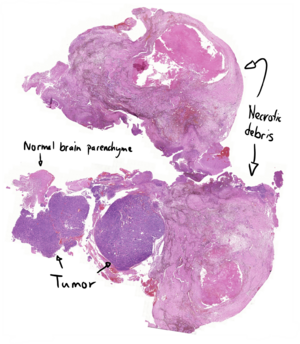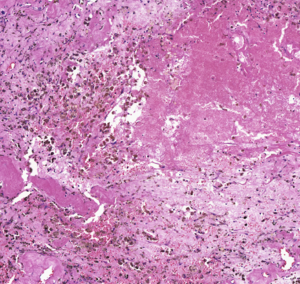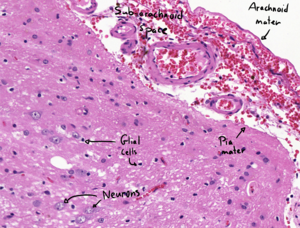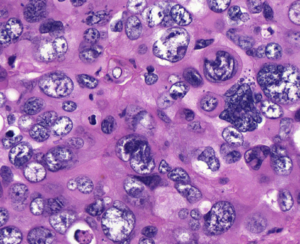38. Anaplastic carcinoma (brain metastasis): Difference between revisions
(Created page with "'''Staining''': HE '''Organ''': Brain '''Description''': We can see four sections. Two of them are necrotic debris where no cell structure is seen, only a soup of necrotic cells with few visible nuclei. One of the sections shows normal brain parenchyme, where we can see neurons, glial cells, the arachnoid mater and pia mater. The last section is the one of most interest. Here we can see cells with no organization, but they show significant pleomorphism (anisocytosis...") |
(No difference)
|
Revision as of 18:51, 19 May 2022
Staining: HE
Organ: Brain
Description:
We can see four sections. Two of them are necrotic debris where no cell structure is seen, only a soup of necrotic cells with few visible nuclei.
One of the sections shows normal brain parenchyme, where we can see neurons, glial cells, the arachnoid mater and pia mater.
The last section is the one of most interest. Here we can see cells with no organization, but they show significant pleomorphism (anisocytosis, anisonucleosis, anisochromasia), we can see mitotic figures and giant cells.
Diagnosis: Anaplastic brain carcinoma
Causes:
- Unknown
Theory:
The tumor in this case is a carcinoma, meaning that it is a malignant tumor of epithelial cells. However, these cells bear no characteristics of normal epithelial cells (they don’t produce keratin), which means that they are non-differentiated. A non-differentiated malignant tumor is called an anaplasia or anaplastic tumor.
Comparing the cancer cells in this slide to the cancer cells in slide 36, you can see that the cancer cells here show more pleomorphism, which also shows that these cancer cells are non-differentiated.
The large necrotic segments are necrotic parts of the tumor.





